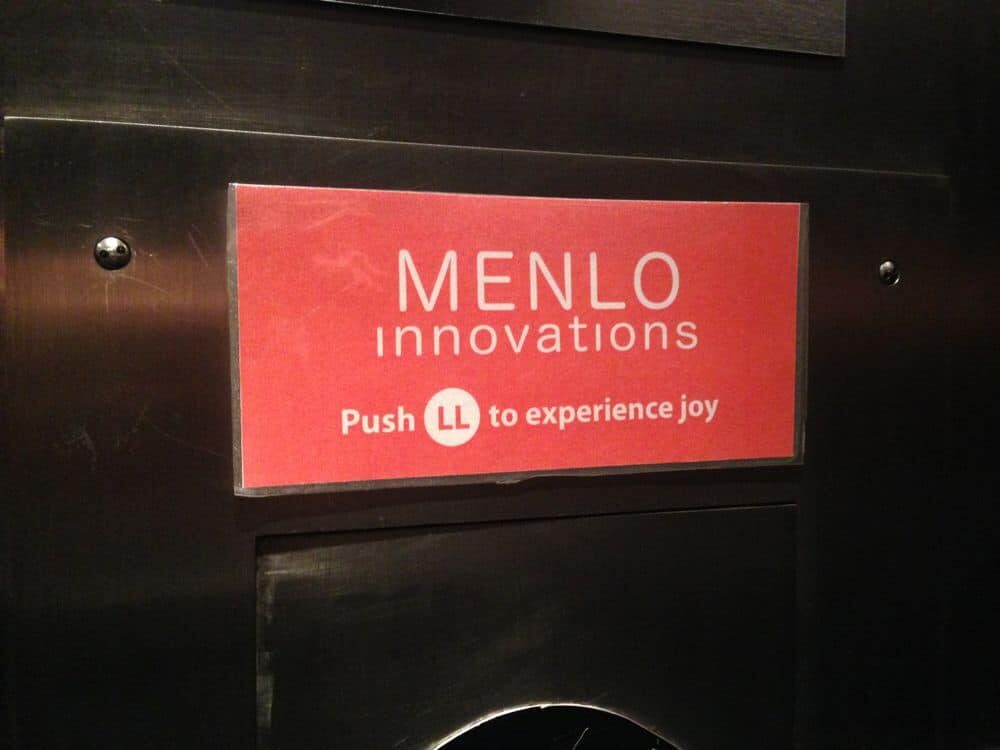Yesterday, I had a chance to visit Menlo Innovations, a software company in Ann Arbor, MI. I was happy to not only meet their CEO (and my recent podcast guest) Rich Sheridan, but to meet team members and get a small glimpse into this interesting environment.
Their open plan office is in the basement under a parking garage, but it's amazingly full of light and life.
The sign at the elevator:

It seemed like a vibrant, joyful workplace. The room buzzed with activity and discussion (driven by the XP paired-programming approach and other activities. People were working hard, but it reminded me of a Toyota plant or a Lean hospital lab, for example — people were working with a purpose, but nobody seems miserable or overworked. They're working because, well, they want to. They're getting paid, but you can tell when a place is more than a paycheck. When you have a strong sense of alignment, people can find joy in work.
I saw their daily team huddle, which took 13 minutes by Rich's timing. Each team member (or pair of programmers) introduces themselves (helpful for new employees and visitors) and talks about what they are working on or they make general announcements.
We talked about the open floor plan and it reminded me of a story I wrote about where a UAW leader who visited Dell Computer saw ESD protective straps and thought we had “tethered” the employees to their workstations to keep them from walking away. Ah, the power of our mental models and lenses.
Some visitors see the open floor plan and think, “Oh, that's so you can keep an eye on everybody, you're watching everybody.” No, it's so people can collaborate or communicate. This is a positive thing (like ESD straps), but it could be seen as something awful (or the open floor plan COULD be awful in the wrong sort of company culture).
As I walked around with Rich, I didn't get ANY sense that people noticed “Oh no, the CEO is here.” It's a comfortable team environment. Rich is very tall (about 6 foot 6 inches) with a deep voice. He has the perfect look to be an old school, scary, intimidating GM factory leader like I used to work with… but thankfully he seems to be the complete opposite of that – the smiling gives him away as a better type of leader.
I had some chats with people about healthcare, when they asked what I do. The metro Detroit area has some very large health systems and one person commented that a certain healthcare organization “didn't seem Lean at all.”
I said, “Well, there are probably pockets of Lean excellence, but it's a really big ship to try to turn.”
His response made me stop and think — “It's even harder to turn a swamp.”
What do you think? Please scroll down (or click) to post a comment. Or please share the post with your thoughts on LinkedIn – and follow me or connect with me there.
Did you like this post? Make sure you don't miss a post or podcast — Subscribe to get notified about posts via email daily or weekly.
Check out my latest book, The Mistakes That Make Us: Cultivating a Culture of Learning and Innovation:










A note about open floor plans and the ability to see so much more:
I was working at a manufacturing company (to remain nameless) where the office desks are separated from the operations by walls, doors, and distance (pretty typical setup).
One day I began situating myself out between the manufacturing lines, setting my laptop on a pallet of soon-to-be-used boxes and making it a de facto workstation. I wanted to better monitor production/quality instead of relying on an electronic monitor, but I also wanted to quickly react if operators needed help or had questions (which was frequently the case). I could be reached via cell phone in the plant by other managers if needed.
I was reprimanded for this activity because managers thought I was spying or looking over the shoulders of operators. The rest of the managers stayed cooped up in their office (which itself had an open floor plan so they could collaborate better).
Anyway, that’s my small vent. I’m happy to see Menlo has a better collaborative culture.
Its great when you find a company were the CEO and employing work so well with one another. I hate when you get a sense of the employees feeling afraid to act normal when the CEO comes around. He sounds like a great guy.
Thanks a lot Mark for this post, sharing your experience at Menlo Innovations.
Open floor offices have triggered me really to dive deep into lean thinking, and shaping knowledge flows across boundaries using information technology.
Seldom to see such good examples as you have experienced lately.
To give an impression what the place looked (and still looks) like where I felt “at home” (BMW Plant Leipzig) http://leanthinkers.blogspot.de/2011/08/bmw-werk-leipzig-semperoper-starbucks.html – the plant manager sat on one of the many desks with no walls around him, fully approachable. It has been a real joy for me to have experienced this.